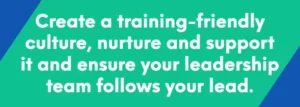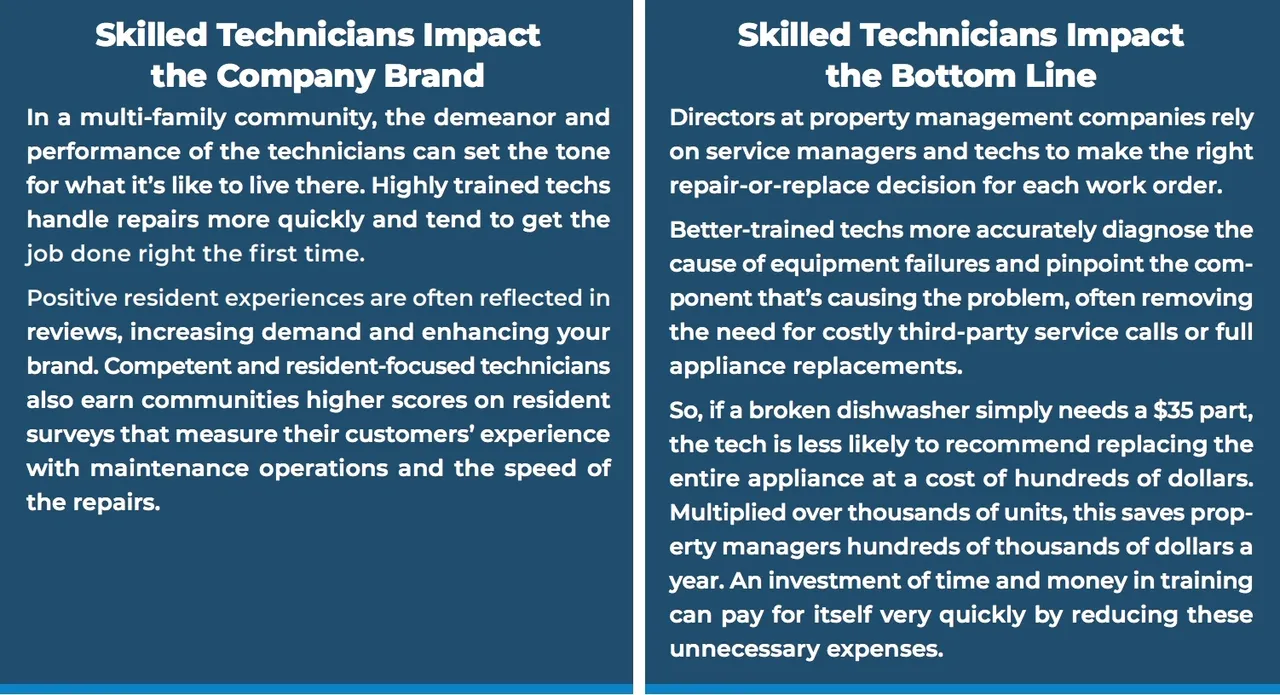WINNING THE TRADES TALENT WAR
Perspectives from Multifamily Property Managers

Three Ways Virtual Training Helps Employers Attract and Keep the Best and Brightest
We’ve all heard it, “time is money.” Invest it or waste it. Whether you’re wasting hours or dollars, the outcome is often the same. Technicians and service managers unavoidably waste hundreds of man-hours each week dealing with what ought to be avoidable issues. The end result?
- Lower Net Operating Income (NOI) for the multifamily property community,
- Less business for the property management company, and
- More costly problems overall.
Yet, while multifamily property managers work with departments dedicated to keeping track of their money, no one is generally tasked with watching time! If they did, many companies might discover their technicians and service managers unavoidably waste hundreds of man-hours each week dealing with what ought to be avoidable issues. First, employee morale and energy sink. With this dynamic in place, turnover increases. Residents grow impatient and reviews suffer. Move outs surge. Your already tired maintenance team begins to burn out.
Your HR, sales, and marketing teams also feel the effect. Problems that could have been averted early on now require more time and money to resolve. The professionals closest to these troubles – the regional directors of maintenance, human resources, and training departments – see that many of these issues can be traced back to the competence of their maintenance teams and the quality of their training. Better-trained techs make repairs faster and do them right the first time, increasing efficiency and productivity. Less-stressed techs who feel that their employer is invested in them are happier in their jobs, making it less likely they’ll leave. And happier techs often make for happier residents, reducing resident turnover. All this adds up to a net increase on the bottom line – to the tune of a 24% return for every additional dollar invested in training.

1: Tap into a new pool of candidates – no experience required
A shortage of experienced technicians means managers need to expand their hiring pool to entry-level technicians. Traditionally these “green new hires” learn skills by shadowing a seasoned technician on-the-job. This makes training newbies part of a lead maintenances’ regular job description—a task they are expected to perform alongside handling service requests. One-on-one training is further complicated by the “two-shoulder” problem. Since maintenance repairs are often conducted in tight spaces with poor lighting, it can be almost impossible for the trainee to get a clear view and understanding of what the mentor is doing during the repair. Virtual training solves these problems by giving entry level techs a “hands-on,” first-person experience. This simulation training also helps them understand the why of the repair process, not just the how. In addition, the training is self-directed and autonomous. So, not only are new techs receiving best-in-class training, they’re getting up to speed quickly without becoming a drag on fellow technicians. Taken together, these advantages enable you to overcome the biggest disadvantage of hiring inexperienced technicians and allow you to tap into a pipeline of new recruits.
2: Attract Millennials by adapting to changing expectations
Formal training gives companies the edge in attracting talent. Not just any training will do, however. Today, even skilled tradespeople expect to be trained using technology. And that doesn’t mean just watching a talking head read PowerPoint slides. They want training that’s interactive, intuitive, and entertaining.
The demand for sophisticated digital training is only going to increase. Millennials – already the largest working generation in America – expect immersive training that keeps them engaged by turning learning into a game. The generation coming up behind them, even more. If you’re leaning toward implementing VR as part of your immersion, know that recall increases to a full 90% because of how life-like the learning is.
3: Give your experienced techs a formal path for advancement
When the labor market is tight, property management companies refrain from promoting from within for fear of leaving onsite operations further understaffed. While that can make sense in the short term, it’s a risky move. Techs that are ready for promotion may be lured away by other companies promising higher-level positions, higher pay, and more opportunity for growth. This is why companies must enhance the employee experience through formal training, upskilling, and opportunities for advancement. Without an ongoing focus on promotion pathing and overall career betterment, techs may decide to move to a company that does.
By The Numbers: By 2028, there will be 370,000 open maintenance technician positions Only 30% of multi-family residential maintenance technicians stay in their job for a year or more.
Quite simply, implementing an effective training program takes an investment of time. Regional maintenance directors often resist giving their employees more training to do because they recognize they’re already understaffed, burning out, or overworked.
They believe their technicians don’t have the time to take training each week in addition to their regular workload. They worry that forcing training on their technicians will lead to more work for the techs, more complaints from residents, and more headaches for staff in other departments.
This is why support from senior, mid-level, and onsite leaders prioritizing training is critical.
Creating a Training-Friendly Culture is Key
A formal training program can solve many problems, but only when implemented correctly. Leadership must be fully committed and excited to support learning. Successful companies have their teams in training, maintenance, and HR work closely with the C-suite to ensure training is prioritized. They recognize that training positively impacts engagement, productivity, and the bottom line by enabling techs to complete repairs quickly and get them right the first time. The result is more work order completions, less outside vendor contracting, and faster turns.
Investing in people is also important for succession planning. The more companies promote employees from within, the less they need to hire externally. Technicians themselves also know they don’t have to leave to get promoted and make more money. Finally, better entry-level training means you don’t have to hesitate when thinking about promoting from within.
Tips for Encouraging and Incentivizing Training
• Set aside 30 minutes for training at the beginning of a shift, before the day gets too busy.
• Enter training time into your work order system, so techs take the training instead of completing a work order during that time.
• Tie completion of training to bonuses and promotions, or give gift cards or other small rewards for reaching training milestones.
• Recognize top finishers publicly and in meetings.
• Have regular conversations with techs about the training. Did they complete their hours? Make sure it’s top of mind.
• Conduct quarterly check-ups focused on a path to promotion. What does the tech need to do to be positioned for advancement?
Conclusion
Hiring and retention represent a huge challenge for multi-family property managers. You could wait for it to improve – maybe the Great Resignation will wane with the pandemic or technology advances to the point that robots can replace techs. However, with the graying of the workforce, the odds are the situation is going to get worse. So, it’s decision time. When it comes to attracting and retaining technicians, you must decide between being proactive versus reactive, between growth and inertia. Whether you use training to get entry level techs up-to-speed more quickly, upskill experienced techs to keep them sharp, or provide opportunities for professional advancement, offering virtual training – and creating a culture that encourages its use – can be transformative to your business and to the lives of your workers.
Sourced from: Winning the Talent War: Give Techs Time and Real-Life Scenarios to Train Themselves, a White Paper from Interplay Learning
